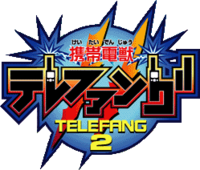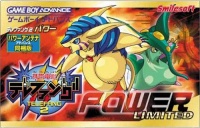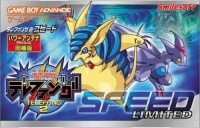Telefang 2: Difference between revisions
No edit summary |
m (→Plot) |
||
| (25 intermediate revisions by 6 users not shown) | |||
| Line 1: | Line 1: | ||
{{Infobox game | {{Infobox game | ||
| name = Keitai Denjuu Telefang 2 | | name=Keitai Denjuu Telefang 2 | ||
| | | ja=携帯電獣テレファング 2 | ||
| romaji = Keitai Denjuu Terefangu 2 | | romaji = Keitai Denjuu Terefangu 2 | ||
| series = Telefang | | series = Telefang | ||
| Line 9: | Line 9: | ||
| image = [[Image:Telefang 2 Power version.jpg|200px]] | | image = [[Image:Telefang 2 Power version.jpg|200px]] | ||
| image2 = [[Image:Telefang 2 Speed version.jpg|200px]] | | image2 = [[Image:Telefang 2 Speed version.jpg|200px]] | ||
| developer = Smilesoft | | developer = Natsume | ||
| | | publisher = Smilesoft | ||
| release-date = 26th April 2002 | |||
| genre = {{w|Console role-playing game}} | | genre = {{w|Console role-playing game}} | ||
| platform = Game Boy Advance}} | | platform = Game Boy Advance}} | ||
'''Keitai Denjuu Telefang 2''' is the sequel to the [[Telefang 1|first Telefang game]] for the Game Boy Advance. Taking place in a different part of the [[Denjuu]] world from the first one, this game shares some qualities with Telefang 1. The battle system is similar, as is the gathering-phone-numbers system, but a good deal of things are quite different from the original. | '''Keitai Denjuu Telefang 2''' is the sequel to the [[Telefang 1|first Telefang game]] for the Game Boy Advance. Taking place in a different part of the [[Denjuu]] world from the first one, this game shares some qualities with Telefang 1. The battle system is similar, as is the gathering-phone-numbers system, but a good deal of things are quite different from the original. Limited-edition versions of the game included a peripheral called the [[Power Antenna]]. | ||
==Plot== | ==Plot== | ||
The game follows a blue-haired protagonist | The game follows a blue-haired protagonist named [[Kyou]], by default, as he journeys on his quest to become a [[T-Fanger]]. Along the way, he encounters [[Diabolos]], who is not content with humans entering the Denjuu universe and so is killing off the [[Antenna Tree]]s, thereby cutting off access to the Human World. | ||
With only one | With only one Antenna Tree in existence, that tree was the only entrance left from the human's world to the Denjuu's world. The player, naturally, must stop him before he is stuck in the world forever. <ref>http://www.rocketcompany.co.jp/t2/t2_003.html</ref> | ||
==Characters== | |||
===Humans=== | |||
{{main|List of people}} | |||
* '''Kyou''' {{lang|ja=キョウ}} | |||
* '''Midori''' {{lang|ja=ミドリ}} | |||
* '''Yuu''' {{lang|ja=ユウ}} | |||
* '''Otome''' {{lang|ja=オトメ}} | |||
* '''Matsukiyo''' {{lang|ja=マツキヨ}} | |||
===Denjuu=== | |||
* '''[[Rex (Basic)|Rex]]''' {{lang|ja=レックス}} | |||
* '''[[Doon (Basic)|Doon]]''' {{lang|ja=ドーン}} | |||
* '''[[Gyuun (Basic)|Gyuun]]''' {{lang|ja=ギューン}} | |||
* '''[[Chakor (Basic)|Chakor]]''' {{lang|ja=チャコル}} | |||
* '''[[Diabolos (Basic)|Diabolos]]''' {{lang|ja=ディアボロス}} | |||
==Changes from Telefang 1== | ==Changes from Telefang 1== | ||
| Line 26: | Line 43: | ||
* The sprites were redrawn | * The sprites were redrawn | ||
* The background music was changed | * The background music was changed | ||
* New Denjuu were introduced | * New Denjuu were introduced, while some old Denjuu were removed | ||
* [[Move types]] were introduced, and a Denjuu which has a [[type]] disadvantage would not necessarily lose if it has good [[moves]]. | * [[Move types]] were introduced, and a Denjuu which has a [[type]] disadvantage would not necessarily lose if it has good [[moves]]. | ||
* In Telefang 1, the starter partner would be different in both versions ([[Crypto]] and [[Fungus]]), while in Telefang 2 it would be [[Rex]] for both versions. | * In Telefang 1, the starter partner would be different in both versions ([[Crypto]] and [[Fungus]]), while in Telefang 2 it would be [[Rex]] for both versions. | ||
* The new Denjuu [[ | * The new Denjuu [[fusion evolve]] differently. Unlike the old Denjuu, their [[habitat type]] would change as they fusion evolve. For fusion evolved Denjuu that return in Telefang 2, their types have changed to reflect this pattern. Fusion evolution is also reversible in Telefang 2. | ||
* Some Denjuu evolve differently, with many evolution chains drastically shortened or even completely removed. | * Some Denjuu evolve differently, with many evolution chains drastically shortened or even completely removed. | ||
* In battle, each Denjuu has a friend that is specific to a Denjuu, which randomly appears and attacks the opponent. | * In battle, each Denjuu has a friend that is specific to a Denjuu, which randomly appears and attacks the opponent. | ||
* In Telefang 1, wild Denjuu cannot be seen before battling them | * In Telefang 1, wild Denjuu cannot be seen before battling them, except in some specific areas. In Telefang 2, wild Denjuu can be seen in the overworld, and coming close to one will cause a battle to start. | ||
==Power and Speed version differences== | |||
* The rival and his or her partner Denjuu are different depending on the version. Otome and Gyuun appear in Speed, while Yuu and Doon appear in Power. | |||
* Certain Denjuu can only be found in one version. | |||
* The colour of the [[D-Shot]] menu and the skins that the player can buy to customize it are different in each version. | |||
==Manga== | |||
{{main|Telefang 2 manga}} | |||
A manga based on the series was serialized in {{w|Comic Bom Bom}} from February to July in 2002. Unlike the manga based on [[Telefang 1]], it was only published in Comic Bom Bom and never re-released as volumes. | |||
==Promotions== | |||
To tie in with the release of the game, a promotional T2 logo or Rex mascot keychain were given out at certain Japanese stores.<ref>http://s15.zetaboards.com/Tulunk_Village/topic/6936243/1/</ref> Special Telefang 2 themed issues of Comic Bom Bom were also given out at certain stores and contained a [[Secret Denjuu|secret phone number]] to be used in the game.<ref>https://telefang.meowcorp.us/bombom/tele2ad20024part4.jpg</ref> | |||
==Release== | ==Release== | ||
| Line 43: | Line 73: | ||
* [[Telefang 1]] | * [[Telefang 1]] | ||
* [[List of Denjuu in Telefang 2]] | * [[List of Denjuu in Telefang 2]] | ||
{{Navbox-location-t2}} | |||
[[Category:Telefang 2]] | |||
Latest revision as of 17:12, 27 August 2022
| Keitai Denjuu Telefang 2 携帯電獣テレファング 2 Keitai Denjuu Terefangu 2 | |
  
| |
| Series | Keitai Denjuu Telefang |
|---|---|
| Versions | Power and Speed |
| Developer(s) | Natsume |
| Publisher(s) | Smilesoft |
| Release date | 26th April 2002 |
| Genre | Console role-playing game |
| Platform | Game Boy Advance |
Keitai Denjuu Telefang 2 is the sequel to the first Telefang game for the Game Boy Advance. Taking place in a different part of the Denjuu world from the first one, this game shares some qualities with Telefang 1. The battle system is similar, as is the gathering-phone-numbers system, but a good deal of things are quite different from the original. Limited-edition versions of the game included a peripheral called the Power Antenna.
Plot[edit]
The game follows a blue-haired protagonist named Kyou, by default, as he journeys on his quest to become a T-Fanger. Along the way, he encounters Diabolos, who is not content with humans entering the Denjuu universe and so is killing off the Antenna Trees, thereby cutting off access to the Human World.
With only one Antenna Tree in existence, that tree was the only entrance left from the human's world to the Denjuu's world. The player, naturally, must stop him before he is stuck in the world forever. [1]
Characters[edit]
Humans[edit]
- Main article: List of people
- Kyou (Japanese: キョウ)
- Midori (Japanese: ミドリ)
- Yuu (Japanese: ユウ)
- Otome (Japanese: オトメ)
- Matsukiyo (Japanese: マツキヨ)
Denjuu[edit]
- Rex (Japanese: レックス)
- Doon (Japanese: ドーン)
- Gyuun (Japanese: ギューン)
- Chakor (Japanese: チャコル)
- Diabolos (Japanese: ディアボロス)
Changes from Telefang 1[edit]
- Main article: Differences between Telefang 1 and Telefang 2
There have been significant differences in the two games, Telefang 1 and 2.
- The sprites were redrawn
- The background music was changed
- New Denjuu were introduced, while some old Denjuu were removed
- Move types were introduced, and a Denjuu which has a type disadvantage would not necessarily lose if it has good moves.
- In Telefang 1, the starter partner would be different in both versions (Crypto and Fungus), while in Telefang 2 it would be Rex for both versions.
- The new Denjuu fusion evolve differently. Unlike the old Denjuu, their habitat type would change as they fusion evolve. For fusion evolved Denjuu that return in Telefang 2, their types have changed to reflect this pattern. Fusion evolution is also reversible in Telefang 2.
- Some Denjuu evolve differently, with many evolution chains drastically shortened or even completely removed.
- In battle, each Denjuu has a friend that is specific to a Denjuu, which randomly appears and attacks the opponent.
- In Telefang 1, wild Denjuu cannot be seen before battling them, except in some specific areas. In Telefang 2, wild Denjuu can be seen in the overworld, and coming close to one will cause a battle to start.
Power and Speed version differences[edit]
- The rival and his or her partner Denjuu are different depending on the version. Otome and Gyuun appear in Speed, while Yuu and Doon appear in Power.
- Certain Denjuu can only be found in one version.
- The colour of the D-Shot menu and the skins that the player can buy to customize it are different in each version.
Manga[edit]
- Main article: Telefang 2 manga
A manga based on the series was serialized in Comic Bom Bom from February to July in 2002. Unlike the manga based on Telefang 1, it was only published in Comic Bom Bom and never re-released as volumes.
Promotions[edit]
To tie in with the release of the game, a promotional T2 logo or Rex mascot keychain were given out at certain Japanese stores.[2] Special Telefang 2 themed issues of Comic Bom Bom were also given out at certain stores and contained a secret phone number to be used in the game.[3]
Release[edit]
This game was only ever released in Japanese; however, there are hackers who have been able to edit the hexadecimal values in the ROM images to release an English patch.
References[edit]
See also[edit]
Takedama Village ・ Takedama Forest ・ Tokaribe Field ・ Tokaribe Village ・ Kufumoku Mountain ・ Chiawata Village ・ Chiawata Forest ・ Meribaro Forest ・ Meribaro Village ・ Kiwatora Field ・ Kiwatora Village ・ Kiwatora Coast ・ Tekku Sea ・ Helchika Desert ・ Helchika Village ・ Bijinia Desert ・ Bijinia Village ・ Uraani Forest ・ Uraani Tides ・ Uraani Village ・ Barusuta Forest ・ Ujichichi Mountain ・ Holy Land Iasuka
Takedama Cave ・ Kufumoku Cave ・ Chiawata Cave ・ Hiero Loophole ・ Bandit's Hideout ・ Kamishino Ruins ・ Uraani Cave ・ Barusuta Cave ・ Ujichichi Cave ・ Karatsumu Cave